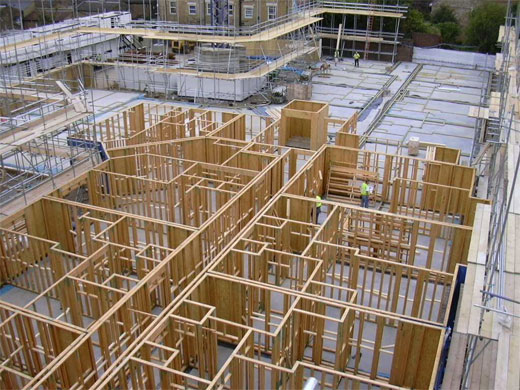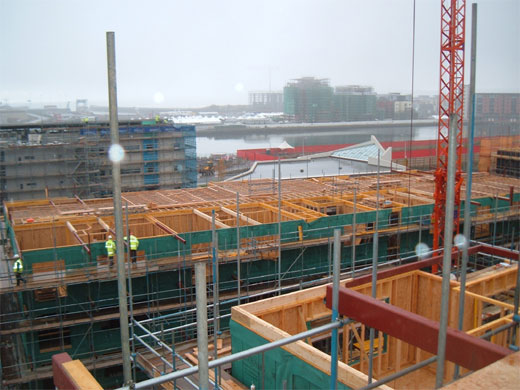Lewis Taylor of TRADA Technology's ![]() Building Performance Division comments on pending changes to Approved Document L, where the thermal performance of party walls will be considered for the first time....
Building Performance Division comments on pending changes to Approved Document L, where the thermal performance of party walls will be considered for the first time....
It was Harlem Brundtland, a former Prime Minister of Norway, who came up with the most quoted and universal definition of 'sustainable development', after four years of study and debate with the World Commission on Environment and Development. It is, in her words, 'development that meets the needs of the present without compromising the ability of future generations to meet their own needs'.
Sustainability goes hand in hand with reducing carbon dioxide (CO2) emissions, with our government impatient to make a significant impact on carbon emissions from dwellings, which account for approximately 25% of all carbon emissions in the UK. Every day we are being warned about the potentially catastrophic effects of global warming - but what are we doing about it? Can we help by reducing our carbon footprint? Choosing to build thermally efficient homes, schools and public buildings made of sustainable materials is one step we might take.
A revised version of Approved Document L of the Building Regulations England & Wales (Conservation of fuel and power) will replace the 2006 iteration later this year. Requirements will be ramped up to bring us closer to the government's well-publicised 2016 zero carbon target, reducing CO2 emissions to Code for Sustainable Homes Level 3 requirements. And if recent policy consultations go as planned, all new non-domestic buildings should also be zero carbon from 2019, with the public sector leading the way from 2018.
The thermal performance of party walls
One of the more fundamental changes proposed for ADL 2010 will be for the first time the consideration of the thermal performance of party walls. This will only affect buildings where thermal performance is calculated independently for different areas, so it won't impact generally on schools and public buildings, but it could have a major impact on housing and residential accommodation – e.g. student halls of residence or nurses' apartments.
Until now, party walls are assumed to have 'perfect' thermal performance, achieving a notional U-value of 0 W/m²K. This is based on the fact that both sides of the wall are within the heated envelope of a building, so there should be no temperature differential from one side to the other, and therefore no heat loss.
Research conducted in 2005 - 2007 by a team at Leeds Metropolitan University, as part of the Stamford Brook field trials, showed that masonry cavity party walls allow a significant amount of air movement with the cavity. This air movement can transfer heat from the party wall cavity to the outside, leading to far greater than predicted heat loss from the building.
The project went on to calculate the actual thermal performance of the party wall based on the excess heat loss and concluded that the U-value of the party wall was between 0.5 and 0.7 W/m²K. In a terraced house, where the area of party wall could be as large if not larger than the external wall, this represents a significant excess heat loss.
Further research then showed that by closing the party wall cavity with insulated cavity barriers, the effective U-value could be reduced to 0.2 W/m²K, and by fully filling the cavity with mineral wool insulation, the U-value was reduced down to 0 W/m²K, i.e. zero heat loss.
The draft SAP 2009 circulated for comment last year and due to be released later this year includes Table 3.5 covering U-values for party walls based on this research. The table states that a solid party wall can assume a U-value of 0 W/m²K because there is no cavity to allow the movement of air. An unfilled open cavity will be assigned a U-value of 0.5 W/m²K, an unfilled cavity that is sealed against air infiltration will be assigned a U-value of 0.2 W/m²K and a fully filled and sealed cavity will assume a perfect 0 W/m²K.

Partially sheathed party walls in a timber frame development
So what does this mean for timber frame buildings? Currently timber frame party walls contain acoustic insulation in both leaves between the timber studs, and insulated cavity barriers around the perimeter of the party wall cavity. This should allow a U-value of 0.2 W/m²K to be assumed for the party walls, based on the criteria set out in SAP 2009. However, this is not a particularly desirable option, because it is still far worse than a perfect wall with no assumed heat loss. As such, it is likely that thermal insulation will need to be installed between the studs as well as in the cavity between the two leaves of the wall, allowing zero heat loss to be assumed.
Achieving this on site may require some changes to current practices. Installation of the insulation between fully sheathed party walls during erection may slow the build progress, as additional time would be needed. Also, ensuring that the insulation remains dry and does not become dislodged during the rest of the build may be difficult.
The simplest solution to these potential problems will be to use unsheathed party walls or only sheathe one leaf. With open or partially open party walls, the insulation can be easily installed once the building is made weathertight. It is also possible to perform site checks. As with masonry cavity walls, if fully sheathed timber frame walls are used and the insulation installed during erection, subsequent checking and snagging would be very difficult.

Changes to current practice lie ahead if new Part L requirements are to be met
Timber frame is ideally suited to buildings with repetitive layouts such as flats and care homes, as well as individual homes, so the new Part L requirements may bring some changes in detailing and order of work, but it will also bring valuable overall improvements which occupants will benefit from, not least valuable savings on fuel costs.

